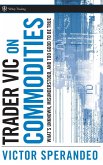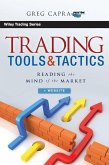Grant Henning
The Value and Momentum Trader
Dynamic Stock Selection Models to Beat the Market [With CDROM]
Grant Henning
The Value and Momentum Trader
Dynamic Stock Selection Models to Beat the Market [With CDROM]
- Broschiertes Buch
- Merkliste
- Auf die Merkliste
- Bewerten Bewerten
- Teilen
- Produkt teilen
- Produkterinnerung
- Produkterinnerung
A winning approach to stock trading based on proprietary statistical research in Excel In The Value and Momentum Trader, Grant Henning presents a comprehensive approach to stock trading, which centers around Excel-based research methods he has developed. In this book, Henning presents the trading tools he has used to become a successful trader, and discusses some of the greatest challenges facing active market participants. This reliable resource presents both winning trading systems and all the skills necessary to perform as a trader as market conditions change. It also demonstrates how you…mehr
Andere Kunden interessierten sich auch für
![Chronicles of a Million Dollar Trader Chronicles of a Million Dollar Trader]() Don MillerChronicles of a Million Dollar Trader31,99 €
Don MillerChronicles of a Million Dollar Trader31,99 €![Day One Trader Day One Trader]() John SussexDay One Trader26,99 €
John SussexDay One Trader26,99 €![The Universal Principles of Successful Trading The Universal Principles of Successful Trading]() Brent PenfoldThe Universal Principles of Successful Trading48,99 €
Brent PenfoldThe Universal Principles of Successful Trading48,99 €![The Profitable Art and Science The Profitable Art and Science]() Mark Andrew LimThe Profitable Art and Science50,99 €
Mark Andrew LimThe Profitable Art and Science50,99 €![Trader Vic on Commodities Trader Vic on Commodities]() Victor SperandeoTrader Vic on Commodities48,99 €
Victor SperandeoTrader Vic on Commodities48,99 €![Trading Tools and Tactics, + Website Trading Tools and Tactics, + Website]() Greg CapraTrading Tools and Tactics, + Website50,99 €
Greg CapraTrading Tools and Tactics, + Website50,99 €![Full-View Integrated Technical Full-View Integrated Technical]() Xin XieFull-View Integrated Technical96,99 €
Xin XieFull-View Integrated Technical96,99 €-
-
-
A winning approach to stock trading based on proprietary statistical research in Excel In The Value and Momentum Trader, Grant Henning presents a comprehensive approach to stock trading, which centers around Excel-based research methods he has developed. In this book, Henning presents the trading tools he has used to become a successful trader, and discusses some of the greatest challenges facing active market participants. This reliable resource presents both winning trading systems and all the skills necessary to perform as a trader as market conditions change. It also demonstrates how you can turn the successes and failures of any trading system into an interactive feedback loop to discover one's true trading skills. * Provides a solid understanding of the author's statistical trading system * Explores how to execute optimal trades under different market conditions * Outlines a very affordable Excel-based stock analysis method that is easy to implement * Dr. Henning has proven to be a trusted author with other academic publications in the areas of measurement and statistics. The Value and Momentum Trader is an essential guide to trading today's dynamic markets.
Hinweis: Dieser Artikel kann nur an eine deutsche Lieferadresse ausgeliefert werden.
Hinweis: Dieser Artikel kann nur an eine deutsche Lieferadresse ausgeliefert werden.
Produktdetails
- Produktdetails
- Verlag: John Wiley & Sons / Wiley
- Seitenzahl: 272
- Erscheinungstermin: 1. Dezember 2009
- Englisch
- Abmessung: 235mm x 157mm x 19mm
- Gewicht: 554g
- ISBN-13: 9780470481738
- ISBN-10: 0470481730
- Artikelnr.: 26571588
- Herstellerkennzeichnung
- Libri GmbH
- Europaallee 1
- 36244 Bad Hersfeld
- gpsr@libri.de
- Verlag: John Wiley & Sons / Wiley
- Seitenzahl: 272
- Erscheinungstermin: 1. Dezember 2009
- Englisch
- Abmessung: 235mm x 157mm x 19mm
- Gewicht: 554g
- ISBN-13: 9780470481738
- ISBN-10: 0470481730
- Artikelnr.: 26571588
- Herstellerkennzeichnung
- Libri GmbH
- Europaallee 1
- 36244 Bad Hersfeld
- gpsr@libri.de
Grant Henning holds a PhD in educational psychology from UCLA, where he specialized in measurement statistics and applied linguistics. He has subsequently served as professor at UCLA, Pennsylvania State University, and several universities in Egypt, Iran, and China. For a number of years, Henning was engaged as senior research scientist at Educational Testing Service, where he conducted evaluative research on university entrance examinations. Henning has authored more than fifty articles, books, and commissioned reports, and has traveled to more than fifty countries over a thirty-year period. In June of 2000, he retired from university service to trade full-time.
List of Tables and Figures xv
Foreword xvii
Preface xix
Acknowledgments xxi
CHAPTER 1 A Philosophy of Trading 1
Analogies 1
Pragmatism 3
Goal-Oriented Behavior 5
Timing 6
Stocks versus Commodities, Options, Mutual Funds, and Bonds 7
Short Trading 9
Use of Margin 10
Trading and Gambling 11
Bold Passion 12
Summary 13
CHAPTER 2 Tools of the Trade 15
Online Access 15
A Reliable Brokerage Account 16
Information 17
Formal Study 18
Analysis Software 20
Protected Workspace 21
Mathematical Trading Systems 21
Market Timing Indicators 22
Summary 22
CHAPTER 3 Constructing Mathematical Models for Stock Selection 25
Technical Approaches to Stock Selection 25
Fundamental Approaches to Stock Selection 26
Hybrid Approaches to Stock Selection 27
The Nature of the Stock Selection Challenge 27
Common Mistakes in System Design for Decision Making 28
Early Beginning Approaches 30
Advantages and Disadvantages of Mathematization 32
Summary 33
CHAPTER 4 Stock Selection: A Technical-Momentum System 35
Qualifying Variables 35
Sample Recommendation Summary Table 39
Questions and Answers 40
Summary 44
CHAPTER 5 Stock Selection: A Fundamental-Value System 45
Qualifying Variables 45
Fundamental Variables 47
Questions and Answers 55
Summary 57
CHAPTER 6 Stock Selection: A Technical-Fundamental Hybrid Approach 59
Qualifying Variables 59
Point-and-Figure Analysis 64
Technical Ratings 64
Other Technical Indicators 65
Price-to-Earnings (PE) Ratio 66
Book Value 67
Earnings Growth 67
EPS/PE Divergence 68
Cash Flow and Free Cash Flow 69
Other Fundamental Indicators 70
Questions and Answers 71
Summary 74
CHAPTER 7 Buying Stocks 75
Preparing the Slate of Candidates 75
Gathering Intel 76
Demanding Supply 77
Cost Averaging 77
Limit and Market Orders 78
Avoiding Purchases with Unsettled Funds 82
Summary 82
CHAPTER 8 Selling Stocks 85
Setting Targets 86
Setting Partial Targets 86
Using Stop-Loss Orders 87
Culling Out Losers 88
Rank Indicators 88
Holding Limits 89
Breaking the 50-Day Moving Average 90
Identifying Market Downturns 90
Summary 91
CHAPTER 9 Portfolio Management 93
Diversifying Over Stocks 93
Diversifying Over Sectors 95
Record Keeping 95
Proportionality over Portfolios 96
Proportionality over Individual Stocks 97
Turnover Ratio 97
Timing the Market 98
Summary 98
CHAPTER 10 Market Timing 99
Mythological Indicators 100
Quasi-Mythological Indicators 101
Reliable Indicators 102
Summary 108
CHAPTER 11 A Performance Record 109
Performance Caveats 109
Hindsight is 20/20 112
Summary 113
CHAPTER 12 A Typical Trading Day 115
Before the Bell 115
The First Half Hour 117
Midday Monitoring 118
After the Closing 119
Weekends 120
Summary 121
CHAPTER 13 Threats to Success 123
Actions of the Federal Reserve Board Open Markets Committee 123
Analyst Downgrades 129
"Pump-and-Dump" Ploys 130
Message Board Panning 131
Market Maker Meddling 131
Negative News Events 132
Large Position Dumping 133
Overhead: Taxes, Commissions, Margin Interest, Spreads 134
Summary 135
CHAPTER 14 A Summary of Trading Principles 137
Never Follow a Tip without Due Diligence 137
Don't Get Grounded on Low Volume 138
Never Buy at the High for the Day 138
Never Sell at the Low for the Day 138
Remember Why You Bought 139
Don't Get Too Attached to Any Stock 139
Maintain Diversification 140
Don't Overtrade 140
Don't Hesitate to Reacquire a Winner 141
Don't Get Your Guidance from Message Boards 141
Maintain Your Own Trading Identity 142
Read Widely 142
Back Off Periodically 143
Seldom if Ever Buy with Unsettled Funds 143
Look to Sell with the Same Level of Zeal That You Look to Buy 143
Maintain a Trading Journal or Diary 144
Gather Information on Your Holdings Daily 144
Learn from Your Mistakes 145
Don't Damage the Environment for Others 145
Don't Let Yourself Become Discouraged 146
Learn to Time General Market Trends 146
Don't Begrudge the Paying of Dues 147
Set Realistic, Measurable Goals for Trading Gains 147
Don't Take Advice from Investment Professionals 147
Avoid Buying a Stock Immediately After It Has Made a Huge Price Run Up 148
Avoid Selling a Stock Immediately After It Has Had a Huge Loss 148
Maintain Your Discipline 149
Don't Hesitate to Sell Good Stocks When Macro Market Indicators Signal a
Downturn 149
Focus More on Avoiding Great Losses than on Making Great Gains 149
Continually Be Watching for Success Predictors 150
Summary 150
CHAPTER 15 Morality in the Marketplace 151
Integrity Defined 152
The Gravity of the Effects of Declining Integrity 153
Conditions that Can Promote the Erosion of Integrity 155
Possible Solutions to the Problems that Promote the Erosion of Integrity
161
Summary 168
CHAPTER 16 Random Walk or Rational Wager 171
Predictability and Probability 173
The Limits of Predictability 174
Following the Numbers or Following the Gurus 176
The Accuracy and Use of Mathematical Models 180
Predictable Market Phenomena 181
Summary 185
CHAPTER 17 On the Nature of Risk 187
The Risks of Risk Management Applied to Market Phenomena 190
Risk and Variance 191
Risk and Compassion 191
Risk and Trust 193
Risk and Wealth 195
Summary 195
CHAPTER 18 Trading in the Information Age 197
The Economy of Abundance 197
A Perspective on Abundance 199
Taking Advantage of Information-Access Opportunities 201
Summary 202
CHAPTER 19 Using a Trading System with an Excel Spreadsheet 203
Step 1: Loading the Excel Spreadsheet into Your Computer 203
Step 2: Recognizing Information on the Spreadsheet 205
Step 3: Updating Your Spreadsheet 210
Step 4: Running the Analysis 212
Step 5: Interpreting the Results 214
Step 6: Maintaining the Spreadsheet 214
Cautionary Reminders 215
Summary 215
CHAPTER 20 Afterthoughts 217
Timing 217
Opportunities 218
Market Trends 219
Lessons from History 220
Conclusion 224
Bibliography 225
About the Author 229
Index 235
Foreword xvii
Preface xix
Acknowledgments xxi
CHAPTER 1 A Philosophy of Trading 1
Analogies 1
Pragmatism 3
Goal-Oriented Behavior 5
Timing 6
Stocks versus Commodities, Options, Mutual Funds, and Bonds 7
Short Trading 9
Use of Margin 10
Trading and Gambling 11
Bold Passion 12
Summary 13
CHAPTER 2 Tools of the Trade 15
Online Access 15
A Reliable Brokerage Account 16
Information 17
Formal Study 18
Analysis Software 20
Protected Workspace 21
Mathematical Trading Systems 21
Market Timing Indicators 22
Summary 22
CHAPTER 3 Constructing Mathematical Models for Stock Selection 25
Technical Approaches to Stock Selection 25
Fundamental Approaches to Stock Selection 26
Hybrid Approaches to Stock Selection 27
The Nature of the Stock Selection Challenge 27
Common Mistakes in System Design for Decision Making 28
Early Beginning Approaches 30
Advantages and Disadvantages of Mathematization 32
Summary 33
CHAPTER 4 Stock Selection: A Technical-Momentum System 35
Qualifying Variables 35
Sample Recommendation Summary Table 39
Questions and Answers 40
Summary 44
CHAPTER 5 Stock Selection: A Fundamental-Value System 45
Qualifying Variables 45
Fundamental Variables 47
Questions and Answers 55
Summary 57
CHAPTER 6 Stock Selection: A Technical-Fundamental Hybrid Approach 59
Qualifying Variables 59
Point-and-Figure Analysis 64
Technical Ratings 64
Other Technical Indicators 65
Price-to-Earnings (PE) Ratio 66
Book Value 67
Earnings Growth 67
EPS/PE Divergence 68
Cash Flow and Free Cash Flow 69
Other Fundamental Indicators 70
Questions and Answers 71
Summary 74
CHAPTER 7 Buying Stocks 75
Preparing the Slate of Candidates 75
Gathering Intel 76
Demanding Supply 77
Cost Averaging 77
Limit and Market Orders 78
Avoiding Purchases with Unsettled Funds 82
Summary 82
CHAPTER 8 Selling Stocks 85
Setting Targets 86
Setting Partial Targets 86
Using Stop-Loss Orders 87
Culling Out Losers 88
Rank Indicators 88
Holding Limits 89
Breaking the 50-Day Moving Average 90
Identifying Market Downturns 90
Summary 91
CHAPTER 9 Portfolio Management 93
Diversifying Over Stocks 93
Diversifying Over Sectors 95
Record Keeping 95
Proportionality over Portfolios 96
Proportionality over Individual Stocks 97
Turnover Ratio 97
Timing the Market 98
Summary 98
CHAPTER 10 Market Timing 99
Mythological Indicators 100
Quasi-Mythological Indicators 101
Reliable Indicators 102
Summary 108
CHAPTER 11 A Performance Record 109
Performance Caveats 109
Hindsight is 20/20 112
Summary 113
CHAPTER 12 A Typical Trading Day 115
Before the Bell 115
The First Half Hour 117
Midday Monitoring 118
After the Closing 119
Weekends 120
Summary 121
CHAPTER 13 Threats to Success 123
Actions of the Federal Reserve Board Open Markets Committee 123
Analyst Downgrades 129
"Pump-and-Dump" Ploys 130
Message Board Panning 131
Market Maker Meddling 131
Negative News Events 132
Large Position Dumping 133
Overhead: Taxes, Commissions, Margin Interest, Spreads 134
Summary 135
CHAPTER 14 A Summary of Trading Principles 137
Never Follow a Tip without Due Diligence 137
Don't Get Grounded on Low Volume 138
Never Buy at the High for the Day 138
Never Sell at the Low for the Day 138
Remember Why You Bought 139
Don't Get Too Attached to Any Stock 139
Maintain Diversification 140
Don't Overtrade 140
Don't Hesitate to Reacquire a Winner 141
Don't Get Your Guidance from Message Boards 141
Maintain Your Own Trading Identity 142
Read Widely 142
Back Off Periodically 143
Seldom if Ever Buy with Unsettled Funds 143
Look to Sell with the Same Level of Zeal That You Look to Buy 143
Maintain a Trading Journal or Diary 144
Gather Information on Your Holdings Daily 144
Learn from Your Mistakes 145
Don't Damage the Environment for Others 145
Don't Let Yourself Become Discouraged 146
Learn to Time General Market Trends 146
Don't Begrudge the Paying of Dues 147
Set Realistic, Measurable Goals for Trading Gains 147
Don't Take Advice from Investment Professionals 147
Avoid Buying a Stock Immediately After It Has Made a Huge Price Run Up 148
Avoid Selling a Stock Immediately After It Has Had a Huge Loss 148
Maintain Your Discipline 149
Don't Hesitate to Sell Good Stocks When Macro Market Indicators Signal a
Downturn 149
Focus More on Avoiding Great Losses than on Making Great Gains 149
Continually Be Watching for Success Predictors 150
Summary 150
CHAPTER 15 Morality in the Marketplace 151
Integrity Defined 152
The Gravity of the Effects of Declining Integrity 153
Conditions that Can Promote the Erosion of Integrity 155
Possible Solutions to the Problems that Promote the Erosion of Integrity
161
Summary 168
CHAPTER 16 Random Walk or Rational Wager 171
Predictability and Probability 173
The Limits of Predictability 174
Following the Numbers or Following the Gurus 176
The Accuracy and Use of Mathematical Models 180
Predictable Market Phenomena 181
Summary 185
CHAPTER 17 On the Nature of Risk 187
The Risks of Risk Management Applied to Market Phenomena 190
Risk and Variance 191
Risk and Compassion 191
Risk and Trust 193
Risk and Wealth 195
Summary 195
CHAPTER 18 Trading in the Information Age 197
The Economy of Abundance 197
A Perspective on Abundance 199
Taking Advantage of Information-Access Opportunities 201
Summary 202
CHAPTER 19 Using a Trading System with an Excel Spreadsheet 203
Step 1: Loading the Excel Spreadsheet into Your Computer 203
Step 2: Recognizing Information on the Spreadsheet 205
Step 3: Updating Your Spreadsheet 210
Step 4: Running the Analysis 212
Step 5: Interpreting the Results 214
Step 6: Maintaining the Spreadsheet 214
Cautionary Reminders 215
Summary 215
CHAPTER 20 Afterthoughts 217
Timing 217
Opportunities 218
Market Trends 219
Lessons from History 220
Conclusion 224
Bibliography 225
About the Author 229
Index 235
List of Tables and Figures xv
Foreword xvii
Preface xix
Acknowledgments xxi
CHAPTER 1 A Philosophy of Trading 1
Analogies 1
Pragmatism 3
Goal-Oriented Behavior 5
Timing 6
Stocks versus Commodities, Options, Mutual Funds, and Bonds 7
Short Trading 9
Use of Margin 10
Trading and Gambling 11
Bold Passion 12
Summary 13
CHAPTER 2 Tools of the Trade 15
Online Access 15
A Reliable Brokerage Account 16
Information 17
Formal Study 18
Analysis Software 20
Protected Workspace 21
Mathematical Trading Systems 21
Market Timing Indicators 22
Summary 22
CHAPTER 3 Constructing Mathematical Models for Stock Selection 25
Technical Approaches to Stock Selection 25
Fundamental Approaches to Stock Selection 26
Hybrid Approaches to Stock Selection 27
The Nature of the Stock Selection Challenge 27
Common Mistakes in System Design for Decision Making 28
Early Beginning Approaches 30
Advantages and Disadvantages of Mathematization 32
Summary 33
CHAPTER 4 Stock Selection: A Technical-Momentum System 35
Qualifying Variables 35
Sample Recommendation Summary Table 39
Questions and Answers 40
Summary 44
CHAPTER 5 Stock Selection: A Fundamental-Value System 45
Qualifying Variables 45
Fundamental Variables 47
Questions and Answers 55
Summary 57
CHAPTER 6 Stock Selection: A Technical-Fundamental Hybrid Approach 59
Qualifying Variables 59
Point-and-Figure Analysis 64
Technical Ratings 64
Other Technical Indicators 65
Price-to-Earnings (PE) Ratio 66
Book Value 67
Earnings Growth 67
EPS/PE Divergence 68
Cash Flow and Free Cash Flow 69
Other Fundamental Indicators 70
Questions and Answers 71
Summary 74
CHAPTER 7 Buying Stocks 75
Preparing the Slate of Candidates 75
Gathering Intel 76
Demanding Supply 77
Cost Averaging 77
Limit and Market Orders 78
Avoiding Purchases with Unsettled Funds 82
Summary 82
CHAPTER 8 Selling Stocks 85
Setting Targets 86
Setting Partial Targets 86
Using Stop-Loss Orders 87
Culling Out Losers 88
Rank Indicators 88
Holding Limits 89
Breaking the 50-Day Moving Average 90
Identifying Market Downturns 90
Summary 91
CHAPTER 9 Portfolio Management 93
Diversifying Over Stocks 93
Diversifying Over Sectors 95
Record Keeping 95
Proportionality over Portfolios 96
Proportionality over Individual Stocks 97
Turnover Ratio 97
Timing the Market 98
Summary 98
CHAPTER 10 Market Timing 99
Mythological Indicators 100
Quasi-Mythological Indicators 101
Reliable Indicators 102
Summary 108
CHAPTER 11 A Performance Record 109
Performance Caveats 109
Hindsight is 20/20 112
Summary 113
CHAPTER 12 A Typical Trading Day 115
Before the Bell 115
The First Half Hour 117
Midday Monitoring 118
After the Closing 119
Weekends 120
Summary 121
CHAPTER 13 Threats to Success 123
Actions of the Federal Reserve Board Open Markets Committee 123
Analyst Downgrades 129
"Pump-and-Dump" Ploys 130
Message Board Panning 131
Market Maker Meddling 131
Negative News Events 132
Large Position Dumping 133
Overhead: Taxes, Commissions, Margin Interest, Spreads 134
Summary 135
CHAPTER 14 A Summary of Trading Principles 137
Never Follow a Tip without Due Diligence 137
Don't Get Grounded on Low Volume 138
Never Buy at the High for the Day 138
Never Sell at the Low for the Day 138
Remember Why You Bought 139
Don't Get Too Attached to Any Stock 139
Maintain Diversification 140
Don't Overtrade 140
Don't Hesitate to Reacquire a Winner 141
Don't Get Your Guidance from Message Boards 141
Maintain Your Own Trading Identity 142
Read Widely 142
Back Off Periodically 143
Seldom if Ever Buy with Unsettled Funds 143
Look to Sell with the Same Level of Zeal That You Look to Buy 143
Maintain a Trading Journal or Diary 144
Gather Information on Your Holdings Daily 144
Learn from Your Mistakes 145
Don't Damage the Environment for Others 145
Don't Let Yourself Become Discouraged 146
Learn to Time General Market Trends 146
Don't Begrudge the Paying of Dues 147
Set Realistic, Measurable Goals for Trading Gains 147
Don't Take Advice from Investment Professionals 147
Avoid Buying a Stock Immediately After It Has Made a Huge Price Run Up 148
Avoid Selling a Stock Immediately After It Has Had a Huge Loss 148
Maintain Your Discipline 149
Don't Hesitate to Sell Good Stocks When Macro Market Indicators Signal a
Downturn 149
Focus More on Avoiding Great Losses than on Making Great Gains 149
Continually Be Watching for Success Predictors 150
Summary 150
CHAPTER 15 Morality in the Marketplace 151
Integrity Defined 152
The Gravity of the Effects of Declining Integrity 153
Conditions that Can Promote the Erosion of Integrity 155
Possible Solutions to the Problems that Promote the Erosion of Integrity
161
Summary 168
CHAPTER 16 Random Walk or Rational Wager 171
Predictability and Probability 173
The Limits of Predictability 174
Following the Numbers or Following the Gurus 176
The Accuracy and Use of Mathematical Models 180
Predictable Market Phenomena 181
Summary 185
CHAPTER 17 On the Nature of Risk 187
The Risks of Risk Management Applied to Market Phenomena 190
Risk and Variance 191
Risk and Compassion 191
Risk and Trust 193
Risk and Wealth 195
Summary 195
CHAPTER 18 Trading in the Information Age 197
The Economy of Abundance 197
A Perspective on Abundance 199
Taking Advantage of Information-Access Opportunities 201
Summary 202
CHAPTER 19 Using a Trading System with an Excel Spreadsheet 203
Step 1: Loading the Excel Spreadsheet into Your Computer 203
Step 2: Recognizing Information on the Spreadsheet 205
Step 3: Updating Your Spreadsheet 210
Step 4: Running the Analysis 212
Step 5: Interpreting the Results 214
Step 6: Maintaining the Spreadsheet 214
Cautionary Reminders 215
Summary 215
CHAPTER 20 Afterthoughts 217
Timing 217
Opportunities 218
Market Trends 219
Lessons from History 220
Conclusion 224
Bibliography 225
About the Author 229
Index 235
Foreword xvii
Preface xix
Acknowledgments xxi
CHAPTER 1 A Philosophy of Trading 1
Analogies 1
Pragmatism 3
Goal-Oriented Behavior 5
Timing 6
Stocks versus Commodities, Options, Mutual Funds, and Bonds 7
Short Trading 9
Use of Margin 10
Trading and Gambling 11
Bold Passion 12
Summary 13
CHAPTER 2 Tools of the Trade 15
Online Access 15
A Reliable Brokerage Account 16
Information 17
Formal Study 18
Analysis Software 20
Protected Workspace 21
Mathematical Trading Systems 21
Market Timing Indicators 22
Summary 22
CHAPTER 3 Constructing Mathematical Models for Stock Selection 25
Technical Approaches to Stock Selection 25
Fundamental Approaches to Stock Selection 26
Hybrid Approaches to Stock Selection 27
The Nature of the Stock Selection Challenge 27
Common Mistakes in System Design for Decision Making 28
Early Beginning Approaches 30
Advantages and Disadvantages of Mathematization 32
Summary 33
CHAPTER 4 Stock Selection: A Technical-Momentum System 35
Qualifying Variables 35
Sample Recommendation Summary Table 39
Questions and Answers 40
Summary 44
CHAPTER 5 Stock Selection: A Fundamental-Value System 45
Qualifying Variables 45
Fundamental Variables 47
Questions and Answers 55
Summary 57
CHAPTER 6 Stock Selection: A Technical-Fundamental Hybrid Approach 59
Qualifying Variables 59
Point-and-Figure Analysis 64
Technical Ratings 64
Other Technical Indicators 65
Price-to-Earnings (PE) Ratio 66
Book Value 67
Earnings Growth 67
EPS/PE Divergence 68
Cash Flow and Free Cash Flow 69
Other Fundamental Indicators 70
Questions and Answers 71
Summary 74
CHAPTER 7 Buying Stocks 75
Preparing the Slate of Candidates 75
Gathering Intel 76
Demanding Supply 77
Cost Averaging 77
Limit and Market Orders 78
Avoiding Purchases with Unsettled Funds 82
Summary 82
CHAPTER 8 Selling Stocks 85
Setting Targets 86
Setting Partial Targets 86
Using Stop-Loss Orders 87
Culling Out Losers 88
Rank Indicators 88
Holding Limits 89
Breaking the 50-Day Moving Average 90
Identifying Market Downturns 90
Summary 91
CHAPTER 9 Portfolio Management 93
Diversifying Over Stocks 93
Diversifying Over Sectors 95
Record Keeping 95
Proportionality over Portfolios 96
Proportionality over Individual Stocks 97
Turnover Ratio 97
Timing the Market 98
Summary 98
CHAPTER 10 Market Timing 99
Mythological Indicators 100
Quasi-Mythological Indicators 101
Reliable Indicators 102
Summary 108
CHAPTER 11 A Performance Record 109
Performance Caveats 109
Hindsight is 20/20 112
Summary 113
CHAPTER 12 A Typical Trading Day 115
Before the Bell 115
The First Half Hour 117
Midday Monitoring 118
After the Closing 119
Weekends 120
Summary 121
CHAPTER 13 Threats to Success 123
Actions of the Federal Reserve Board Open Markets Committee 123
Analyst Downgrades 129
"Pump-and-Dump" Ploys 130
Message Board Panning 131
Market Maker Meddling 131
Negative News Events 132
Large Position Dumping 133
Overhead: Taxes, Commissions, Margin Interest, Spreads 134
Summary 135
CHAPTER 14 A Summary of Trading Principles 137
Never Follow a Tip without Due Diligence 137
Don't Get Grounded on Low Volume 138
Never Buy at the High for the Day 138
Never Sell at the Low for the Day 138
Remember Why You Bought 139
Don't Get Too Attached to Any Stock 139
Maintain Diversification 140
Don't Overtrade 140
Don't Hesitate to Reacquire a Winner 141
Don't Get Your Guidance from Message Boards 141
Maintain Your Own Trading Identity 142
Read Widely 142
Back Off Periodically 143
Seldom if Ever Buy with Unsettled Funds 143
Look to Sell with the Same Level of Zeal That You Look to Buy 143
Maintain a Trading Journal or Diary 144
Gather Information on Your Holdings Daily 144
Learn from Your Mistakes 145
Don't Damage the Environment for Others 145
Don't Let Yourself Become Discouraged 146
Learn to Time General Market Trends 146
Don't Begrudge the Paying of Dues 147
Set Realistic, Measurable Goals for Trading Gains 147
Don't Take Advice from Investment Professionals 147
Avoid Buying a Stock Immediately After It Has Made a Huge Price Run Up 148
Avoid Selling a Stock Immediately After It Has Had a Huge Loss 148
Maintain Your Discipline 149
Don't Hesitate to Sell Good Stocks When Macro Market Indicators Signal a
Downturn 149
Focus More on Avoiding Great Losses than on Making Great Gains 149
Continually Be Watching for Success Predictors 150
Summary 150
CHAPTER 15 Morality in the Marketplace 151
Integrity Defined 152
The Gravity of the Effects of Declining Integrity 153
Conditions that Can Promote the Erosion of Integrity 155
Possible Solutions to the Problems that Promote the Erosion of Integrity
161
Summary 168
CHAPTER 16 Random Walk or Rational Wager 171
Predictability and Probability 173
The Limits of Predictability 174
Following the Numbers or Following the Gurus 176
The Accuracy and Use of Mathematical Models 180
Predictable Market Phenomena 181
Summary 185
CHAPTER 17 On the Nature of Risk 187
The Risks of Risk Management Applied to Market Phenomena 190
Risk and Variance 191
Risk and Compassion 191
Risk and Trust 193
Risk and Wealth 195
Summary 195
CHAPTER 18 Trading in the Information Age 197
The Economy of Abundance 197
A Perspective on Abundance 199
Taking Advantage of Information-Access Opportunities 201
Summary 202
CHAPTER 19 Using a Trading System with an Excel Spreadsheet 203
Step 1: Loading the Excel Spreadsheet into Your Computer 203
Step 2: Recognizing Information on the Spreadsheet 205
Step 3: Updating Your Spreadsheet 210
Step 4: Running the Analysis 212
Step 5: Interpreting the Results 214
Step 6: Maintaining the Spreadsheet 214
Cautionary Reminders 215
Summary 215
CHAPTER 20 Afterthoughts 217
Timing 217
Opportunities 218
Market Trends 219
Lessons from History 220
Conclusion 224
Bibliography 225
About the Author 229
Index 235








